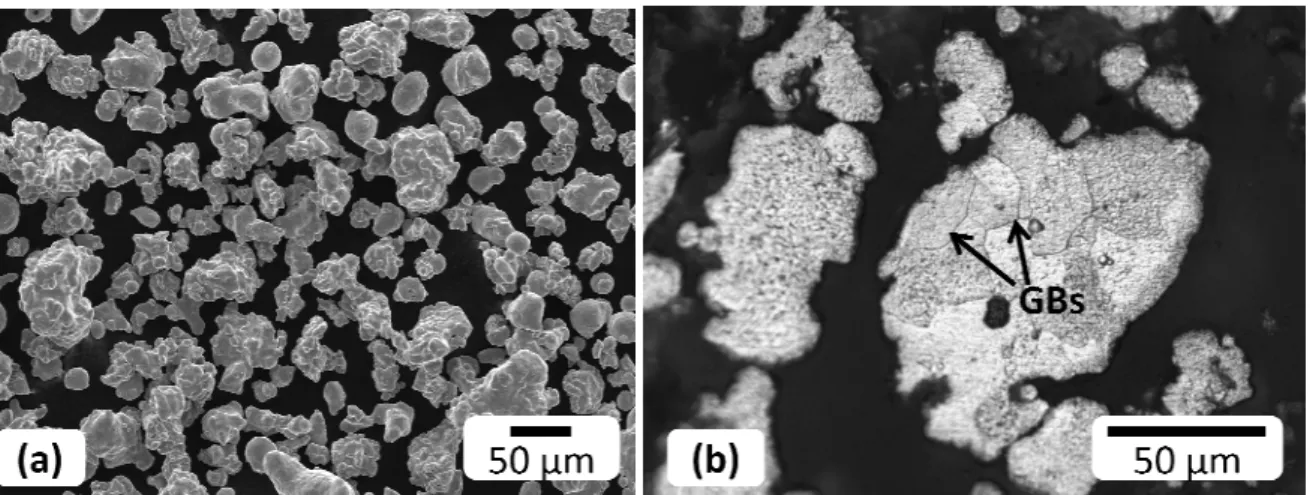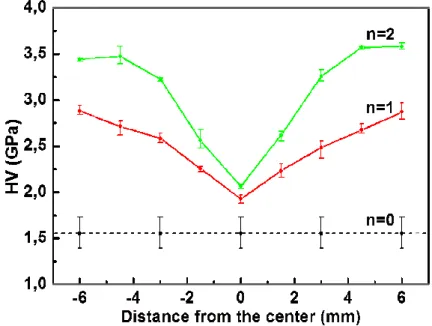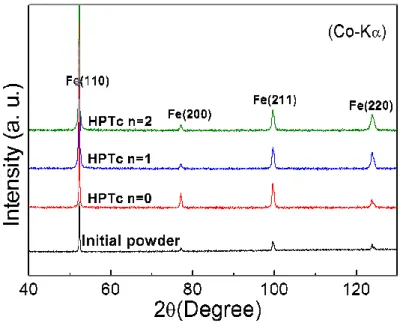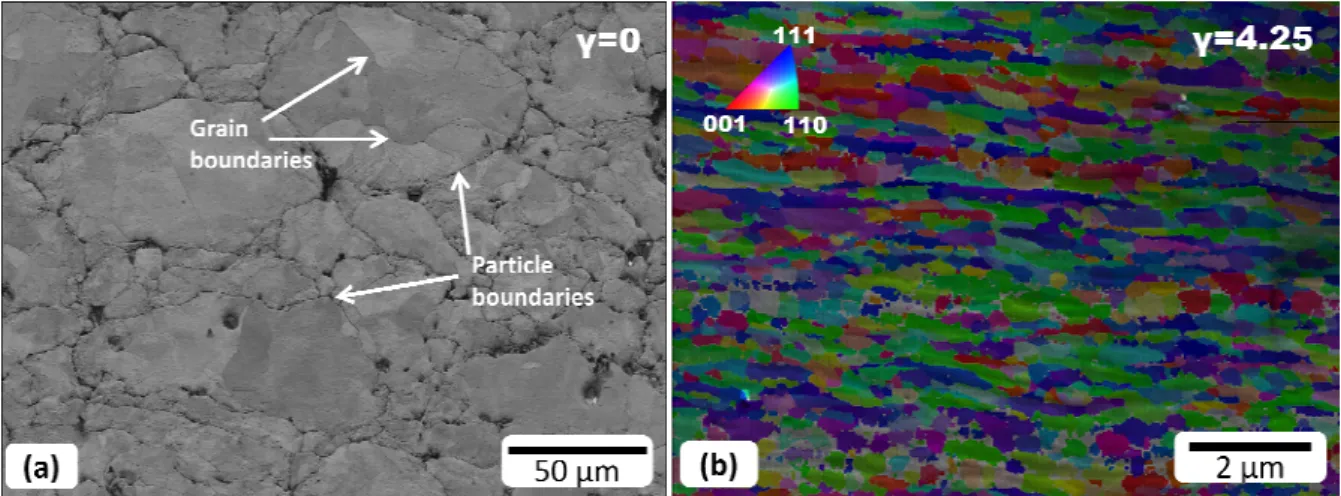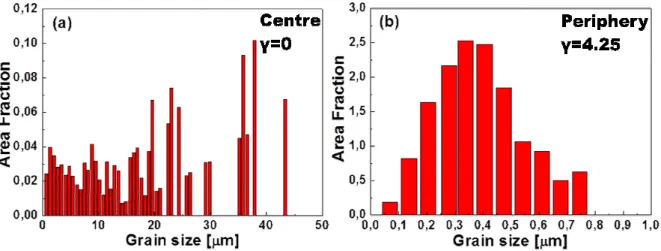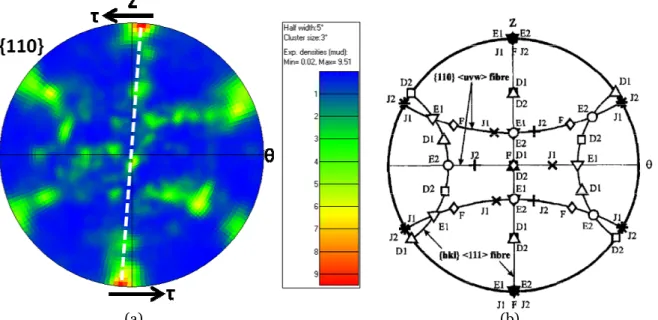HAL Id: hal-01518024
https://hal.univ-lorraine.fr/hal-01518024
Submitted on 4 May 2017HAL is a multi-disciplinary open access archive for the deposit and dissemination of sci-entific research documents, whether they are pub-lished or not. The documents may come from teaching and research institutions in France or abroad, or from public or private research centers.
L’archive ouverte pluridisciplinaire HAL, est destinée au dépôt et à la diffusion de documents scientifiques de niveau recherche, publiés ou non, émanant des établissements d’enseignement et de recherche français ou étrangers, des laboratoires publics ou privés.
and densification of iron powder consolidated by high
pressure torsion
Yajun Zhao, Roxane Massion, Thierry Grosdidier, Laszlo S. Toth
To cite this version:
Yajun Zhao, Roxane Massion, Thierry Grosdidier, Laszlo S. Toth. Contribution of shear deforma-tion to grain refinement and densificadeforma-tion of iron powder consolidated by high pressure torsion. 6th International Conference on Nanomaterials by Severe Plastic Deformation, Jun 2014, Metz, France. �10.1088/1757-899X/63/1/012032�. �hal-01518024�
This content has been downloaded from IOPscience. Please scroll down to see the full text.
Download details:
IP Address: 193.54.91.144
This content was downloaded on 04/05/2017 at 09:14 Please note that terms and conditions apply.
Contribution of shear deformation to grain refinement and densification of iron powder
consolidated by high pressure torsion
View the table of contents for this issue, or go to the journal homepage for more 2014 IOP Conf. Ser.: Mater. Sci. Eng. 63 012032
(http://iopscience.iop.org/1757-899X/63/1/012032)
Home Search Collections Journals About Contact us My IOPscience
You may also be interested in:
Microstructure and mechanical properties of continuous equal channel angular pressed Titanium G S Dyakonov, C F Gu, L S Toth et al.
High-Pressure Torsion of Ti: Synchrotron characterization of phase volume fraction and domain sizes Raúl E Bolmaro, Vitor L Sordi, Maurizio Ferrante et al.
Microstructures and mechanical properties of pure tantalum processed by high-pressure torsion Y Huang, N Maury, N X Zhang et al.
A study of plastic deformation behavior during high pressure torsion process by crystal plasticity finite element simulation
P T Wei, C Lu, K Tieu et al.
Fabrication of fine recrystallized grains and their mechanical property in HPT processed pure magnesium
Mohit Joshi, Yuko Fukuta, Si Gao et al.
Grain refinement and Lattice Imperfections in Commercial Aluminum Alloy Processed by Severe Plastic Deformation
Saifeddine Charfeddine, Karim Zehani, Lotfi Besais et al.
The significance of self-annealing in two-phase alloys processed by high-pressure torsion Nian Xian Zhang, Megumi Kawasaki, Yi Huang et al.
Influence of deformation temperature on texture evolution in HPT deformed NiAl C Tränkner, R Chulist, W Skrotzki et al.
Contribution of shear deformation to grain refinement
and densification of iron powder consolidated by high
pressure torsion
Y J ZHAO1*, R Massion1,2, T Grosdidier1,2, L S Toth1,2
1 Laboratoire d'Etude des Microstructures et de Mécanique des Matériaux (LEM3),
Université de Lorraine, Ile du Saulcy, 57045 Metz, France
2 Laboratory of Excellence on Design of Alloy Metals for low-mAss Structures
(DAMAS), Université de Lorraine, Ile du Saulcy, 57045 Metz, France *E-mail: yajun.zhao@univ-lorraine.fr(Y J ZHAO)
Abstract. High Pressure Torsion (HPT) experiments were performed for consolidation of water-atomized pure iron powder (99%) with initial particle sizes of 20-100 µm. The experiments were carried out successfully at room temperature, achieving both low level of residual porosity and significant grain refinement, thanks to the intense shear strain and hydrostatic pressure applied in HPT. X-ray diffraction analysis was carried out on the consolidated samples which revealed no significant proportion of oxides. Considering the inherent heterogeneity of the imposed shear strain in HPT, different positions across the diameters of sample disks were selected for mechanical property and microstructure investigations. The effect of shear deformation on the microstructure and texture was investigated by metallography, scanning electron microscopy, electron backscattered diffraction (EBSD). The micro-hardness and porosity of the samples as a function of shear strain at constant hydrostatic pressure were also measured. The grain size distributions showed homogeneous microstructures with significant grain refinement due to shear deformation. The texture measurements revealed that a shear texture typical to the shear of bcc iron was obtained during HPT compaction of iron powder.
Keywords: High Pressure Torsion, Shear Strain, Powder Consolidation, Grain Refinement, Texture evolution.
1. Introduction
Through the assembly of individual particles or atoms, powder metallurgy (PM) is capable of producing bulk components with very small grain sizes and with special compositions that are not achievable with conventional metallurgical processes. It is also a suitable process to manufacture metals which are hard to deform or melt. In conventional PM, however, in order to obtain full density of the final product, a hot isostatic pressing or sintering stage is always necessary, where a residual porosity level of ~2% can be achieved at high processing temperatures (higher than 800oC for iron) [1]. The sintering usually has to be done using inert atmosphere, which is an extra cost in conventional PM processes. At the same time, the high-temperature process inevitably causes grain growth or might even induces phase changes in the metal, which is considered as a bottle-neck of the conventional PM approach. It is well known that severe plastic deformation (SPD) routes, such as high pressure torsion (HPT) and equal channel angular extrusion (ECAE), can lead to significant microstructure refinement of metals and alloys, by introducing heavy strain and thus high dislocation density to the material [2]. The grain refinement effect of SPD is expected to be viable also for powder materials, which makes the SPD processes promising for consolidation of metal powders. It has already been shown that SPD techniques which imposes severe shear deformation and high hydrostatic pressure to the samples is a very efficient process for consolidating powder [3-5]. Efforts have been done to achieve fully dense products through consolidation of metallic powders by SPD approaches e.g., ECAP [1,6] and HPT [7].
Content from this work may be used under the terms of theCreative Commons Attribution 3.0 licence. Any further distribution of this work must maintain attribution to the author(s) and the title of the work, journal citation and DOI.
Compared to the conventional PM approach,
and achieve fully dense products at room temperature One of the widely used SPD
reports have produced the knowledge with regard to microstructure and distribution [8], hardness [9], etc.
the mechanisms of grain refinement and the texture evolution, which are crucial for the property improvement [10], are rarely reported. In the present work,
powder (99% purity) was consolidated hydrostatic pressure. We focus
compaction process, which could lead to a further understanding powder densification and microstructure refinement during HPT crystallographic texture of the consolidated samples
2. Experimental materials and procedures Water atomized commercially
100 µm in diameter were used in showed that each single particle diameter (Fig. 1b).
Fig. 1. Scanning electron microscop
sizes of 20-100 µm (a) and grain sizes of ~20 µm (b)
The powder was consolidated
dimensions of 20 mm in diameter and consolidation process and the
samples are illustrated schematically steps: first simple axial compression
purpose of investigating the respective contributions of
pressure to the consolidation process, HPT tests were carried ou pressures and rotation angles, introducing
samples. For comparison, the samples were examined also after the first stage of compaction, compacted only under axial pressure without
in the HPT tests are summarized in
e p
the conventional PM approach, the SPD technique is viable to be carried out and achieve fully dense products at room temperature [3], and thus to avoid grain growth
SPD technique for metallic powders consolidation produced the knowledge with regard to microstructure and
], etc.) of different metallic powdersconsolidated
s of grain refinement and the texture evolution, which are crucial for the , are rarely reported. In the present work, commercially pure iron consolidated by HPT with various revolution numbers
focus on the role of shear strain and the hydrostatic pressure o which could lead to a further understanding to
and microstructure refinement during HPT. The evolution of the exture of the consolidated samples is also discussed in the present work. Experimental materials and procedures
y pure (99% purity) iron powders with initial particle size used in the present work (Fig. 1a). The microstructure
showed that each single particle was composed of grains with an average
oscopy images of the initial water atomized Fe powder
100 µm (a) and grain sizes of ~20 µm (b). Some grain boundaries (GBs) are indicated in (b).
consolidated by high pressure torsion (HPT) into disk-shaped samples wi 20 mm in diameter and ~3 mm in thickness at room temperature. The consolidation process and the dimensions of the high pressure torsion consolidated (HPTc)
schematically in Fig. 2. The compaction process was carried first simple axial compression of the initial powder, then HPT rotation. purpose of investigating the respective contributions of shear deformation
pressure to the consolidation process, HPT tests were carried out with different hydrostatic s, introducing different amount of shear strain
samples. For comparison, the samples were examined also after the first stage of compaction, pressure without imposing shear strain. The parameters
are summarized in Table 1.
T
the SPD technique is viable to be carried out to avoid grain growth. technique for metallic powders consolidation is HPT. While
properties (density consolidated through HPT, s of grain refinement and the texture evolution, which are crucial for the commercially pure iron HPT with various revolution numbers at constant the hydrostatic pressure on the the mechanism of he evolution of the also discussed in the present work.
with initial particle sizes 20-icrostructure observations with an average size of ~20 µm in
Fe powder showing particle grain boundaries (GBs) are indicated in
shaped samples with mm in thickness at room temperature. The of the high pressure torsion consolidated (HPTc) The compaction process was carried out in two HPT rotation. With the shear deformation and hydrostatic different hydrostatic of shear strains into the HPTc samples. For comparison, the samples were examined also after the first stage of compaction, he parameters applied
6th International Conference on Nanomaterials by Severe Plastic Deformation IOP Publishing
IOP Conf. Series: Materials Science and Engineering 63 (2014) 012032 doi:10.1088/1757-899X/63/1/012032
Sample Applied pressure(GPa)
1 1.5
2 1.1
3 1.1
4 1.1
Considering the inherent heterogeneity of positions across the diameters of
measurements and microstructure the following formula was employed to the HPTc samples:
Here r represents the radial
number of revolutions. This formula
of the disk remains constant during testing and that θ=2πn.
Fig. 2 Schematic illustration
dimension of the HPTc samples
X-ray diffraction (XRD) analyse performed using Co-Kα radiation.
of electron backscattered diffraction (EBSD) technique using a scanning electron microscope
ground on wet SiC paper up to 6 µm roughness, perchloric acid - alcohol solution.
applying a load of 200 gr for 1 samples were measured using the 3. Results and discussions 3.1 Porosity and Vickers hardness
The measured porosity of the HPTc samples are summarized by means of the Archimedes
temperature. In this section, identify the samples. The result
ressure Rotation angle (radian) Rotation speed (degree/min) π/2 72 2π 72 4π 72 - -
Considering the inherent heterogeneity of the imposed shear strain in HPT, different positions across the diameters of the HPTc samples were selected for
and microstructure observations. According to the definition of shear strain, was employed to calculate the shear strain at each selected position of
γ=2πnr/h .
radial distance from the center, h is the disk thickness and This formula is established under the assumption that
remains constant during testing and that is independent of the rotation angle
of the HPT consolidation process, the local reference system, dimension of the HPTc samples, where τ indicates the rotation direct
ray diffraction (XRD) analyses of the initial powder as well as HPTc samples were Kα radiation. The microstructure and texture were examined by means backscattered diffraction (EBSD) technique using a field emission gun (FEG) scanning electron microscope (SEM). The specimens for EBSD were first
up to 6 µm roughness, which was followed by electro solution. The Vickers hardness (HV) measurements were
for 10 s on the bottom section of the disks. The porosity of the HPTc samples were measured using the Archimedes method in distilled water.
3. Results and discussions and Vickers hardness
orosity of the HPTc samples are summarized in Table 2, which were Archimedes drainage method carried out in distilled water
. In this section, the same serial numbers that shown in Table 1 are used to The results show a quite low level of residual porosity for
Loading time (min) 1.25 5 10 10
imposed shear strain in HPT, different were selected for Vickers hardness According to the definition of shear strain, each selected position of
(1) is the disk thickness and n is the is established under the assumption that the thickness is independent of the rotation angle
, the local reference system, and indicates the rotation direction.
HPTc samples were icrostructure and texture were examined by means field emission gun (FEG) for EBSD were first mechanically electro-polishing in a hardness (HV) measurements were done by the bottom section of the disks. The porosity of the HPTc
able 2, which were obtained distilled water at room in Table 1 are used to a quite low level of residual porosity for all samples
Table 1. Thhe parameters of the HPT consolidation process
consolidated by HPT, as low as the conventional powder metallurgy approach sintering stage is necessary. For
pressure, 4π rotation angle and 10 sample no. 4 (at 1.1 GPa, 10
porosity of the HPTc samples were reduced by the HPT imposed shear strain (at the value of pressure and loading time
significant contribution of the HPT consolidation process.
Sample Rotation angle:
Porosity
Fig. 3 shows the variation of
disks processed with different rotation numbers under a constant GPa. It is apparent that there is a non
section of the HPTc samples with lower values in the center an towards the periphery region.
the average values of HV both at
the heterogeneity of the imposed shear strain in the HPT consolidation process
the value of the Vickers hardness dislocation density introduced by
Fig. 3 Vickers hardness of the HPTc samples processed with different hydrostatic pressure
3.2 Microstructure
as low as the porosity of dense materials (1% conventional powder metallurgy approach where the application of a
For sample no. 3 even lower value was obtained and 10 min loading). Comparing the porosity of sample GPa, 10 min loading, without HTP rotation), it is obvious porosity of the HPTc samples were reduced by the HPT imposed shear strain (at the value of pressure and loading time). The evolution of the porosity indicate
the shear deformation to the densification of
Table 2. Porosity of HPTc samples
Sample: 1 2 3 4
Rotation angle: π/2 2π 4π 0 Porosity (%): 2.06 1.01 0.59 3.02
he variation of the Vickers hardness (HV) across the diameter of the with different rotation numbers under a constant hydrostatic pressure
there is a non-uniform distribution of the hardness
samples with lower values in the center and increasing monotonically . By increasing the rotation numbers there is a clear increase in both at the center and at the periphery of the sample
imposed shear strain calculated by formula (1), we can process the shear deformation is extremely important
hardness. This effect is most probably due to n density introduced by the additional shear strain.
Vickers hardness of the HPTc samples processed with different rotation hydrostatic pressure was 1.1 GPa for all samples.
(1%-2%) produced by where the application of a high temperature value was obtained (0.59 at 1.1 GPa Comparing the porosity of sample no. 3 with it is obvious that the porosity of the HPTc samples were reduced by the HPT imposed shear strain (at the same porosity indicates that there is a f the powders in the
diameter of the sample hydrostatic pressure of 1.1 the hardness within the
cross-asing monotonically here is a clear increase in of the samples. Considering we can conclude that extremely important in increasing . This effect is most probably due to the increased
rotation numbers (n). The
6th International Conference on Nanomaterials by Severe Plastic Deformation IOP Publishing
IOP Conf. Series: Materials Science and Engineering 63 (2014) 012032 doi:10.1088/1757-899X/63/1/012032
The X-ray diffraction (XRD) patterns of
in Fig. 4. The spectrum of the initial water atomized powder
α-Fe phase, other constituents or contaminants like oxides were below detectable limits After consolidation, the patterns of the HPTc samples can be indexed by the same
peaks as the initial powder.
phases or contaminants which could have been advantage of doing consolidation at
The relative intensities of the main reflection peaks in an XRD measurement are indicative of the presence of textures in the samples. Namely, the
(200), (211) and (220) peaks
respectively, which is the case for the
without shear strain (n=0). In contrast, these
samples which is the result of the texture introduced by the
between the initial state and the HPTc case is that the reflection peaks are much broader for the HPTc samples (n=1 and n=2)
of a large dislocation density and a reduction in the
Fig. 4. X-ray diffraction patterns HPTc samples
The role of the shear deformation comparing the microstructures
sample disk. Under a constant hydrostatic pressure, the imposed shear strain of position across the diameter could be calculated by formula
microstructures of positions selected from the central area and the pe HPTc sample no. 1 (at 1.5 GPa pressure,
these positions, the imposed shear strain that the central area of the sample
and the grain size are equal to
respectively. However, in the peripheral region ( refined due to the shear deformation.
boundaries, which are non existing
patterns of the initial powder and the HPTc samples are show The spectrum of the initial water atomized powder revealed the existence of only the Fe phase, other constituents or contaminants like oxides were below detectable limits After consolidation, the patterns of the HPTc samples can be indexed by the same
This result demonstrates that there are no unexpected new which could have been introduced into the samples
advantage of doing consolidation at room temperature.
The relative intensities of the main reflection peaks in an XRD measurement are indicative of the presence of textures in the samples. Namely, the ratios of the peak
), (211) and (220) peaks are close to the 2/3/1 ratios for a random distribution, respectively, which is the case for the initial powder and also for the consolidated sam without shear strain (n=0). In contrast, these ratios change significantly for the
which is the result of the texture introduced by the shear strain.
between the initial state and the HPTc case is that the reflection peaks are much broader for HPTc samples (n=1 and n=2). This broadening of the X-ray peaks are due to
of a large dislocation density and a reduction in the crystallite size.
ray diffraction patterns measured for the initial water atomized iron powder and HPTc samples. n is the revolution number applied in HPT tests
shear deformation during the HPT consolidation process was assessed by comparing the microstructures of different positions selected across the diameter
sample disk. Under a constant hydrostatic pressure, the imposed shear strain of position across the diameter could be calculated by formula (1). Fig.
microstructures of positions selected from the central area and the periphery region of the GPa pressure, π/2 rotation angle and 1.25 min loading
imposed shear strain is γ=0 and 4.25, respectively. sample (Fig. 5a, γ=0) displays equiaxed grain equal to the sizes of the initial powder observed in . However, in the peripheral region (Fig. 5b, γ=4.25), the gr
shear deformation. Note that the central region show are non existing in the peripheral area.
HPTc samples are shown the existence of only the Fe phase, other constituents or contaminants like oxides were below detectable limits. After consolidation, the patterns of the HPTc samples can be indexed by the same reflection there are no unexpected new to the samples, which is the
The relative intensities of the main reflection peaks in an XRD measurement are indicative of peak intensities of the are close to the 2/3/1 ratios for a random distribution, consolidated sample s change significantly for the HPTc Another difference between the initial state and the HPTc case is that the reflection peaks are much broader for are due to the presence
tial water atomized iron powder and for the is the revolution number applied in HPT tests.
HPT consolidation process was assessed by selected across the diameter of the same sample disk. Under a constant hydrostatic pressure, the imposed shear strain of each selected . Fig. 5 shows the riphery region of the min loading time). At It can be observed equiaxed grains. The particle size observed in Fig.1a and b, γ=4.25), the grains are extremely Note that the central region shows coarse particle
Fig. 5 Microstructures of an HPTc sample
shear strain is zero (a) and in the periphery region
figure map in which the radial axis direction within the crystal reference system is shown with a color
The results obtained in the present investigation
on the samples has a dominant role in reducing the porosity and refining the microst of the samples in the HPT consolidation
shear strain in reducing the porosit the shear deformation change with the shear plane, which is hydrostatic pressure [1].
The grain fragmentation process breaks the initial grains into small fragments which can the cavities more easily with the help of
homogeneous microstructure with refined grains and low residual porosity The grain size distributions of the selected areas
and b, respectively, in area fractions
populations of small and large grains up to 44
and 1.42 µm in area weighted and number fraction calculation, respectively. periphery, the distribution is quite narrow with an average grain size of only weighted calculation (the same i
and formulas developed by Toth et al. in [11] were used for the average grain size calculations.
HPTc sample obtained by SEM and EBSD, in the central area
the periphery region where γ=4.25 (b). The latter map is an inverse pole figure map in which the radial axis direction within the crystal reference system is shown with a color
code defined in the insert in (b).
esent investigation indicate that the shear deformation imposed a dominant role in reducing the porosity and refining the microst
consolidation process. Lapovok et al. [1] examined the porosity in powder compaction processes through changes the spherical cavity geometry into an elliptical shape with the shear plane, which is a geometrical effect that favors the closure
grain fragmentation process breaks the initial grains into small fragments which can with the help of the applied hydrostatic pressure.
homogeneous microstructure with refined grains and low residual porosity of the selected areas shown in Fig. 5a and b are
in area fractions. The distribution is bimodal in the central region having populations of small and large grains up to 44 µm size. The average grain size is
m in area weighted and number fraction calculation, respectively. istribution is quite narrow with an average grain size of only weighted calculation (the same in number fraction calculation is 0.20 µ
and formulas developed by Toth et al. in [11] were used for the average grain size
the central area where the . The latter map is an inverse pole figure map in which the radial axis direction within the crystal reference system is shown with a color
shear deformation imposed a dominant role in reducing the porosity and refining the microstructure examined the role of the through ECAP, where to an elliptical shape aligned closure of cavities under
grain fragmentation process breaks the initial grains into small fragments which can fill applied hydrostatic pressure. As a result, a homogeneous microstructure with refined grains and low residual porosity can be achieved.
are plotted in Fig. 6a The distribution is bimodal in the central region having The average grain size is 20.18 µm m in area weighted and number fraction calculation, respectively. However, at the istribution is quite narrow with an average grain size of only 0.39 µm in area µm). The definition and formulas developed by Toth et al. in [11] were used for the average grain size
6th International Conference on Nanomaterials by Severe Plastic Deformation IOP Publishing
IOP Conf. Series: Materials Science and Engineering 63 (2014) 012032 doi:10.1088/1757-899X/63/1/012032
Fig. 6 Grain size distributions of area where the shear strain
3.3 Crystallographic texture
The inverse pole figure map for a selected position γ=1.88 is displayed in Fig. 7.
distinctly elongated in an inclined
angle of about 22o with respect to the shear direction. For the
shear (γ=1.88), nearly the same value can be obtained using the formula
This agreement indicates that
shear during the HPT consolidation process.
Fig. 7 Inverse pole figure map of
Grain size distributions of the HPTc sample deformed by half rotation in HPT. (a): shear strain is zero, (b): at the periphery region where
nverse pole figure map for a selected position at the periphery with shear strain in Fig. 7. The grain structure of the shear deformed area show
an inclined direction; the large axes of the grains with respect to the shear direction. For the given value of , nearly the same value can be obtained using the formula for
β = 0.5 arctan (2/γ)=23.4o
s that the particles were deformed with the expected value of HPT consolidation process.
Fig. 7 Inverse pole figure map of an HPTc sample, deformed by a shear of
deformed by half rotation in HPT. (a): the central here γ=4.25.
with shear strain of of the shear deformed area shows grains the large axes of the grains are inclined at an value of the applied
for shear [12]:
with the expected value of simple
deformed by a shear of γ=1.88.
In order to examine the crystallographic
presented in Fig. 8a. In comparison with the pole figure of ideal orientations (Fig. 8b), i shows clearly that the deformed material develop
The texture is slightly rotated
typical for b.c.c. metals at relatively low shear strains [
(a)
Fig. 8 {110} pole figure shear deformed HPTc sample, with γ=1.88
of shear, and the ideal orientations of b.c.c. shear textures (b) (from Baczynski and Jonas [1
4. Conclusions
High Pressure Torsion (HPT)
room temperature. Low level of residual porosity and significant grain refinement achieved. The Vickers hardness of the samples were increased
imposed shear strain. The shear deformation was reducing the porosity and refining the microstructure
dimension of the particles. In this process there is an effect of the grain process as well. It has been demonstrated that t
simple shear and the consolidated samples
Acknowledgment
This work was supported by the French State through the program "Investment in the future" operated by the National Research Agency (ANR) and referenced by ANR
(Labex DAMAS).
References
[1] Lapovok R, Tomus D and Bettles [2] Segal VM 1995 Mater. Sci. Eng. [3] Valiev RZ, Islamgaliev RK, [4] Valiev RZ, Langdon TG 2006
crystallographic texture, the {110} pole figure obtained from
In comparison with the pole figure of ideal orientations (Fig. 8b), i clearly that the deformed material developed a typical torsion texture of b.c.c. metals
rotated from its symmetry position in the anti-shear direction at relatively low shear strains [13].
(b)
Fig. 8 {110} pole figure shear deformed HPTc sample, with γ=1.88 (a), where arrows indicate the sense the ideal orientations of b.c.c. shear textures (b) (from Baczynski and Jonas [1
Pressure Torsion (HPT) was performed successfully for consolidati
ow level of residual porosity and significant grain refinement Vickers hardness of the samples were increased monotonically with
hear deformation was demonstrated to play a
sity and refining the microstructure by changing both in shape and in . In this process there is an effect of the grain
process as well. It has been demonstrated that the powder particles were consolidated samples developed typical torsion texture
This work was supported by the French State through the program "Investment in the future" operated by the National Research Agency (ANR) and referenced by
ANR-Bettles C 2008 Scr. Mater. 58 898–901 Mater. Sci. Eng. A 197 157
RK, Alexandrov IV 2000 Prog. Mater. Sci. 45 103 TG 2006 Prog. Mater. Sci. 51 881–981
obtained from Fig. 7 is In comparison with the pole figure of ideal orientations (Fig. 8b), it torsion texture of b.c.c. metals. shear direction. This is
where arrows indicate the sense the ideal orientations of b.c.c. shear textures (b) (from Baczynski and Jonas [13]).
for consolidating iron powder at ow level of residual porosity and significant grain refinement was monotonically with the to play a dominant role in by changing both in shape and in . In this process there is an effect of the grain fragmentation were deformed under textures.
This work was supported by the French State through the program "Investment in the future" -11-LABX-0008-01
103–189
6th International Conference on Nanomaterials by Severe Plastic Deformation IOP Publishing
IOP Conf. Series: Materials Science and Engineering 63 (2014) 012032 doi:10.1088/1757-899X/63/1/012032
[5] Shen H, Li Z, Gunther B, Korznikov AV, Valiev RZ 1995 Nanostruct. Mater. 6 385-388 [6] Xia K, Wu X 2005 Scr. Mater. 53 1225–1229
[7] Korznikov AV, Safarov IM, Laptionok V, Valiev RZ 1991 Acta Metall. 39 3193-3197 [8] Martin CL, Bouvard D, Shima S 2003 J. Mech. Phys. Solids 51 667-693
[9] Concustell A, Sort J, Woodcock TG, Gimazov A, et al. 2006 Int. Metall. 14 871 [10] Beyerlein IJ, Toth LS 2009 Prog. Mater. Sci. 54 427-510
[11] Toth LS, Biswas S, Gu ChF, Beausir B 2013 Mater. Charact 84 67-71 [12] Canova GR, Kocks U F, Jonas JJ 1984 Acta Metall. 32 211–226 [13] Baczynski J, Jonas JJ 1996 Acta Meter. 44 4273-4288
